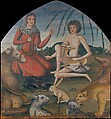Laila and Majnun
Not on view
The top of the painting is shaped to fit into a niche in a wall; it was part of a series of eight works made to decorate a room, all with the subject of love stories from famous Iranian poets. Seven of the eight paintings are currently in the collection of the Brooklyn Museum.
This painting depicting the classic story of Laila and Majnun would therefore originally have been accompanied by images of Bahram Gur and Azada Hunting, Khusrau Discovering Shirin Bathing, and other well-known tales of Persian lore, as well as hunting scenes. Following the established imagery of Laila and Majnun, Majnun is shown here as a skeletal youth, who has retreated to the wilderness, where he lives surrounded by animals after his proposal of marriage is rejected by Laila’s father.
The technique of oil painting on canvas, which was introduced into Iran in the late seventeenth century, was further developed and refined in the eighteenth century and became a major medium of expression in the nineteenth century. In this painting, Laila appears in clothing typical dress of the Zand period (1750–79).
This image cannot be enlarged, viewed at full screen, or downloaded.
This artwork is meant to be viewed from right to left. Scroll left to view more.



